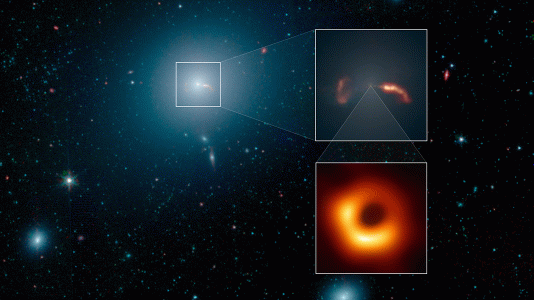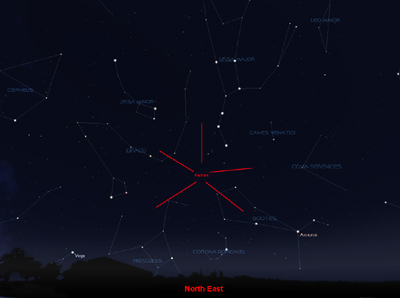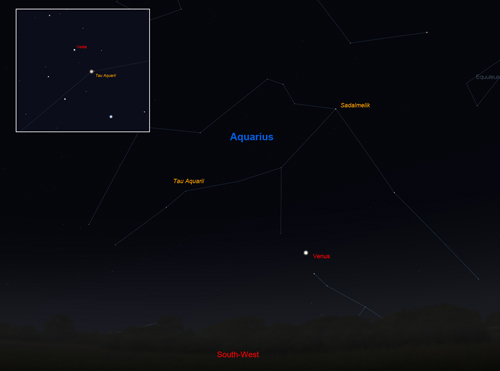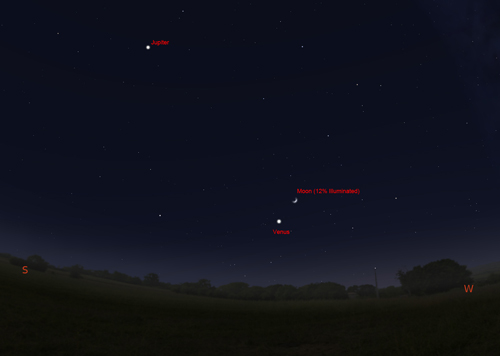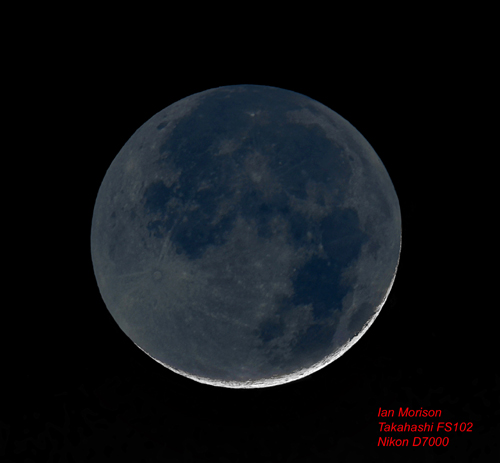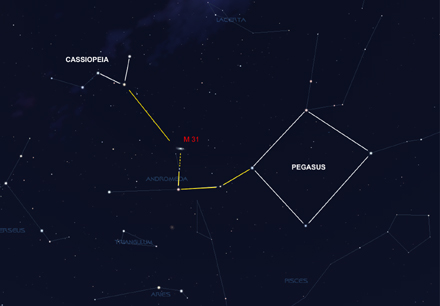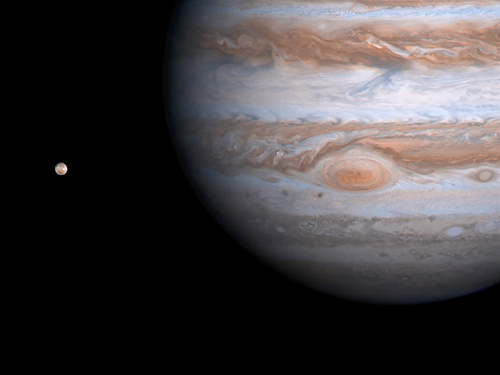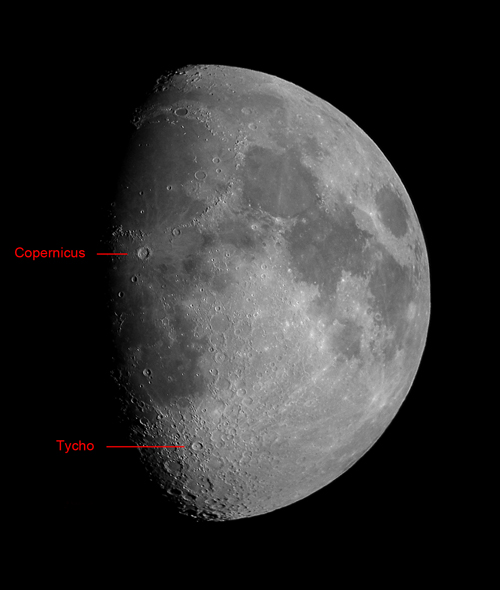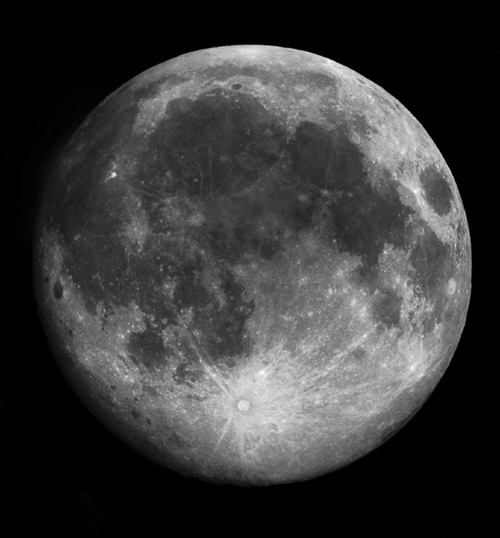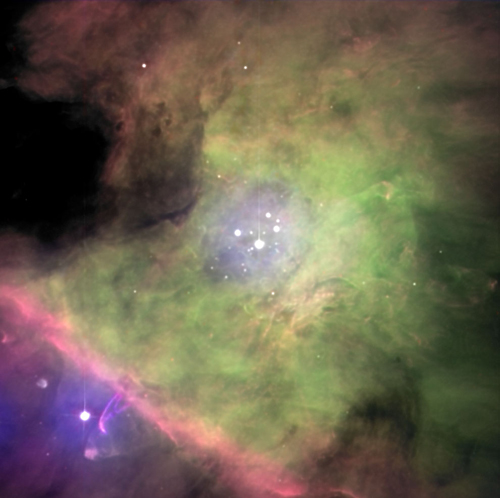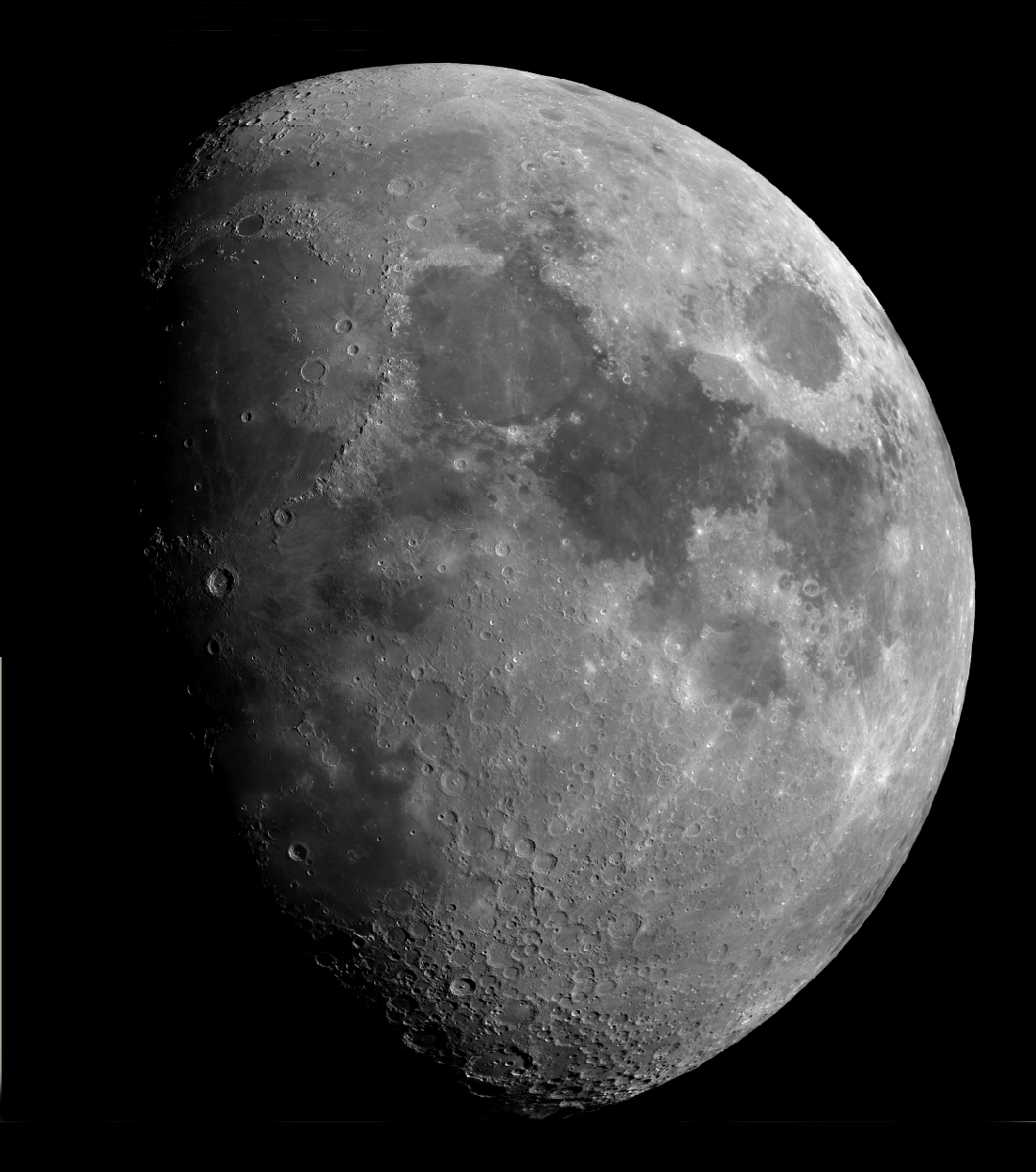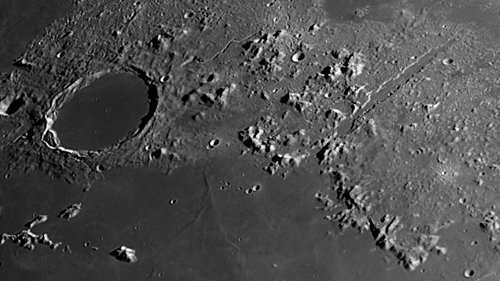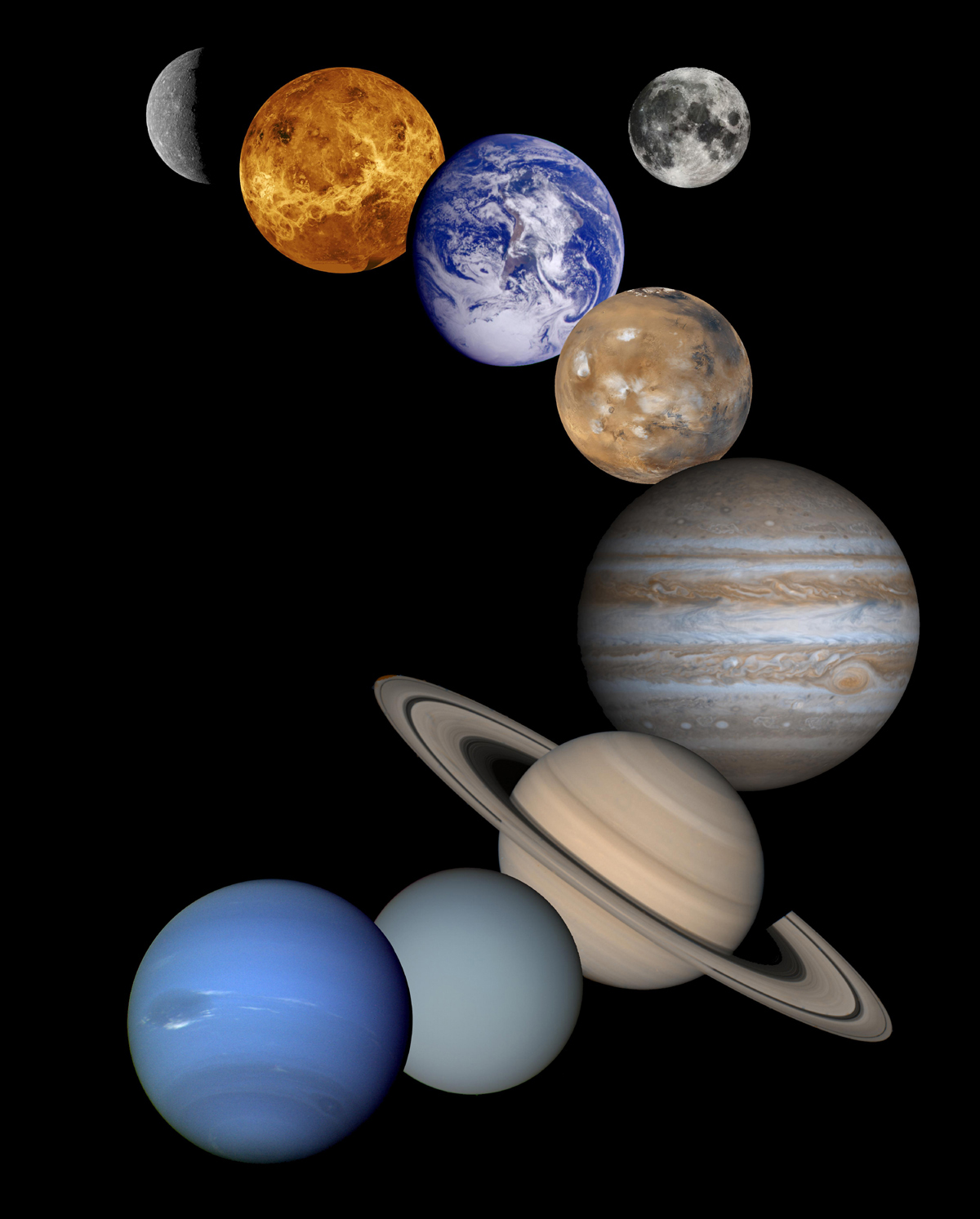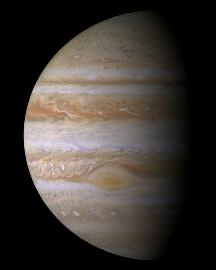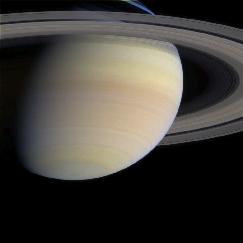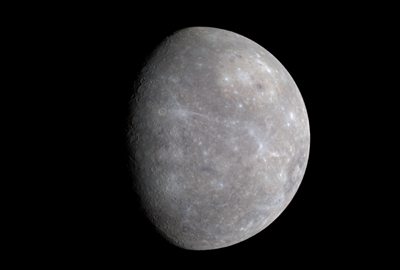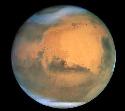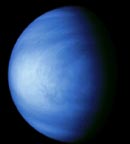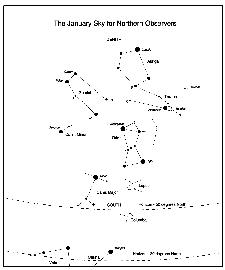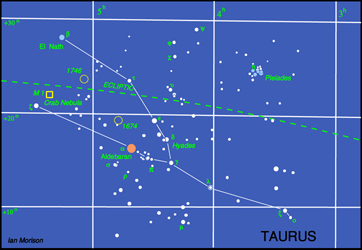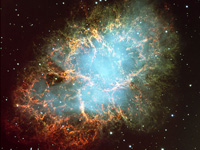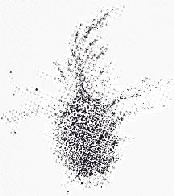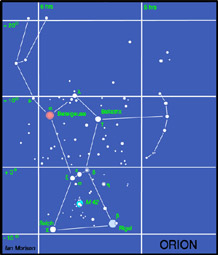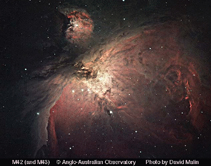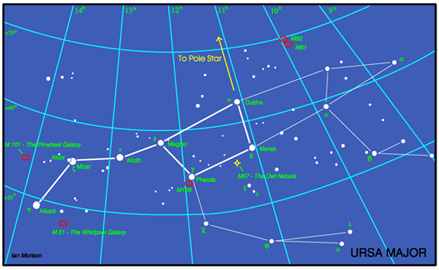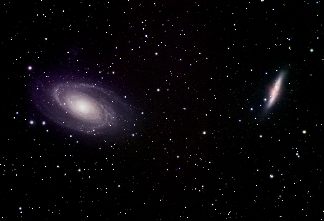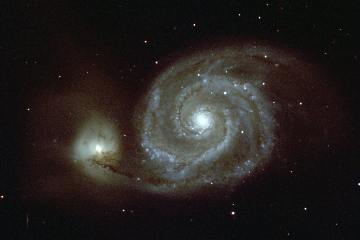The Night Sky January 2012
Compiled by Ian Morison
This page, updated monthly, will let you know some of the things that you can look out for in the night sky. It lists the phases of the Moon, where you will see the naked-eye planets and describes some of the prominent constellations in the night sky during the month.
Image of the Month
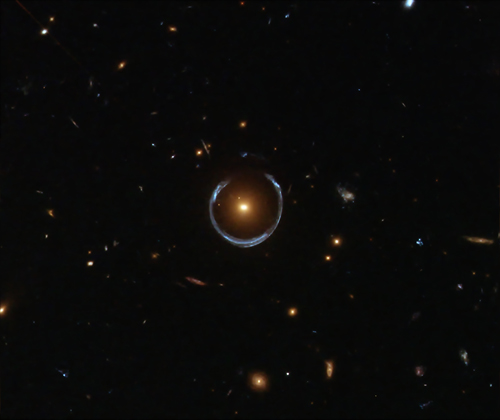
A near perfect Einstein Ring
ESA/HUBBLE and NASA
This image shows how the mass of a red foreground galaxy has distorted the space-time around it forming what is called a "gravitational lens". The lens has warped the light from a far distant galaxy into a near perfect ring. These are called "Einstein Rings" as they arise from a prediction of his General Theory of Relativity. It is rare that the alignment of the two galaxies is close enough to give rise to a ring and, more normally, two distinct images or an arc are seen. The first gravitational lens - called the "Double Quasar" - was discovered using the Lovell Telescope at Jodrell Bank Observatory in 1972.
Highlights of the Month
Night Jan 3rd/4th: the Quadrantid Meteor Shower
The QuadrantidsThe early morning of Jan 4th will give us the chance, if clear, of observing the Quandrantid meteor shower. The shower is expected to peak on the morning of the 4th of January. Happily this year,the Moon just after first quarter will be setting in the west so its light should not hinder our view too much. The radiant - where the meteors appear to come from - is in the constellation Bootes not far below the tail of Ursa Major, the Great Bear. Here there was once a small constellation named after the "Quadrant" which was the device used by early astronomers - most notably Tycho - to measure the elevation of stars as they crossed the meridian (an arc running from horizon, due south, up to the pole star). Given the time at which this happens, it is possible to measure the star's celestial co-ordinates. The peak hourly rate can reach 200, but they are not particularly bright so a good dark observing site will help observe them. Whilst observing this part of the sky look at the central star of the tail of the Great Bear. Binoculars will easily show that there are two stars - Mizar,the brighter and Alcor, the Horse and Rider. You may even spot this with your unaided eye. A small telescope will show that Mizar is a nice double star! If it is clear it will be cold - so wrap up well, wear a woolly hat and have some hot drinks with you!
January 10 after sunset - A chance to spot Vesta
After sunset looking south-west on the 10th January lies the constellation Aquarius. Just up and to the left - just 3 arc minutes - from the fourth magnitude star Tau Aquarii will lie the minor planet Vesta shining at magnitude 8. Though not the largest of the objects in the asteroid belt - that is Ceres, now termed a dwarf planet - Vesta is the brightest.
January 12th, 13th and 14th after sunset : Venus close to Neptune
If you have never seen Neptune, then this month gives you a reasonable chance of picking it up with binoculars close to Venus in the evening twilight sky. Venus shines brightly at magnitude -3.9 whilst Neptunes is just magnitude +8. On the 13th, they are just over 1 degree apart with the 4th magnitude star Iota Aquarii just below Venus so they will all lie well within the field of view of a pair of binoculars.
January 16th - 1 hr before dawn: Saturn, Spica and a Third Quarter Moon
Before dawn on the 16th January, there is a nice grouping of Saturn, Spica and a third quarter Moon. Some hours earlier, as they rise, the three will almost lie in straight line.
January 26th: Venus and a thin crescent Moon.
After sunset at about 4:40 PM on the 26th, you may, given a low south western horizon and clear skies, be able to spot Venus, at magnitude -3.9 down to the lower right of a thin crescent Moon. Look out for the "earthshine" illuminating the "dark side" of the Moon - often called the "old Moon in the new Moon's arms". Jupiter will also be in view high up to the left.
Find M31 - The Andromeda Galaxy - and perhaps M33 in Triangulum
In the early evening, the galaxy M31 in Andromeda is visible high in the south-west to west. The chart provides two ways of finding it:
1) Find the square of Pegasus. Start at the top left star of the square - Alpha Andromedae - and move two stars to the left and round a bit. Then turn 90 degrees to the right, move down to one reasonably bright star and continue a similar distance in the same direction. You should easily spot M31 with binoculars and, if there is a dark sky, you can even see it with your unaided eye. The photons that are falling on your retina left Andromeda well over two million years ago!
2) You can also find M31 by following the "arrow" made by the three rightmost bright stars of Cassiopeia down to the lower left as shown on the chart.
The accompanying image was the first ever taken by the author with a SBIG ST-8300M 8 Mpixel CCD camera mounted on an 80mm Ed refractor from somewhat light polluted and hazy skies near Shrewsbury late November. Perhaps not too bad for a first attempt. M32 is the spherical dwarf elliptical above and M101 the more elongated elliptical below.
Around the night of new Moon (23rd January) you may also be able to spot M33, the third largest galaxy after M31 and our own galaxy in our Local Group of galaxies. It is a face on spiral and its surface brightness is pretty low so a dark, transparent sky will be needed to spot it using binoculars (8x40 or, preferably, 10x50). Follow the two stars back from M31 and continue in the same direction sweeping slowly as you go. It looks like a piece of tissue paper stuck on the sky just a bit brighter than the sky background. Good Hunting!
January: Look for the Great Red Spot on Jupiter
This list gives some the best times during January to observe the Great Red Spot which should then lie close to the central meridian of the planet. The GRS can move in position around the surface and a second set of calculations puts the times of transit a little later than those given.
2nd 22:30 21st 23:15
5th 20:00 22nd 19:07
7th 21:39 24th 20:46
10th 19:09 26th 22:25
14th 22:27 29th 19:55
17th 19:57 31st 21:34
19th 21:36
January 3rd evening: Two Great Lunar Craters
Two great Lunar Craters: Tycho and Copernicus
This is a great night to observe two of the greatest craters on the Moon, Tycho and Copernicus, as the terminator is nearby. Tycho is towards the bottom of Moon in a densely cratered area called the Southern Lunar Highlands. It is a relatively young crater which is about 108 million years old. It is interesting in that it is thought to have been formed by the impact of one of the remnents of an asteroid that gave rise to the asteroid Baptistina. Another asteroid originating from the same breakup may well have caused the Chicxulub crater 65 million years ago. It has a diameter of 85 km and is nearly 5 km deep. At full Moon - seen in the image below - the rays of material that were ejected when it was formed can be see arcing across the surface. Copernicus is about 800 million years old and lies in the eastern Oceanus Procellarum beyond the end of the Apennine Mountains. It is 93 km wide and nearly 4 km deep and is a clasic "terraced" crater. Both can be seen with binoculars.
The trapezium in M42 imaged with the Faulkes Telescope
The Trapezium in M42, imaged by Daniel Duggan.
This image was taken using the Faulkes Telescope North by Daniel Duggan - for some time a member of the Faulkes telescope team. It shows the heart of the Orion Nebula, M42, with at its centre the group of stars known as the Trapezium. It is the light from these stars that illuminates the nebula whilst their ultra-violet light is exciting the hydrogen to emit pink-red light at the H alpha wavelength. This is a beautiful object to observe with a small telescope with, normally, the four brightest of the group being visible but under nights of very good seeing the fifth, to the upper right may be glimpsed.
Learn more about the Faulkes Telescopes and how schools can use them: Faulkes Telescope"
Observe the International Space Station
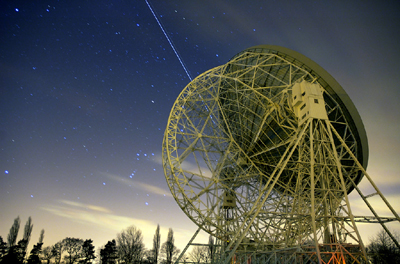
The International Space Station and Jules Verne passing behind the Lovell Telescope on April 1st 2008.
Image by Andrew Greenwood
Use the link below to find when the space station will be visible in the next few days. In general, the space station can be seen either in the hour or so before dawn or the hour or so after sunset - this is because it is dark and yet the Sun is not too far below the horizon so that it can light up the space station. As the orbit only just gets up the the latitude of the UK it will usually be seen to the south, and is only visible for a minute or so at each sighting. Note that as it is in low-earth orbit the sighting details vary quite considerably across the UK. The NASA website linked to below gives details for several cities in the UK. (Across the world too for foreign visitors to this web page.)
Note: I observed the ISS three times recently and was amazed as to how bright it has become.
Find details of sighting possibilities from your location from: Location Index
See where the space station is now: Current Position
The Moon
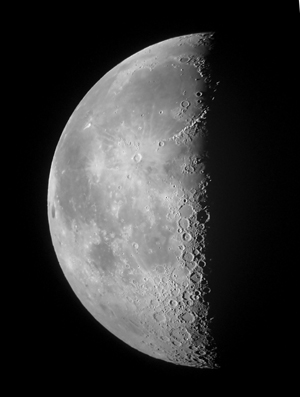
The Moon at 3rd Quarter. Image, by Ian Morison, taken with a 150mm Maksutov-Newtonian and Canon G7.
Just below the crator Plato seen near the top of the image is the mountain "Mons Piton". It casts a long shadow across the maria from which one can calculate its height - about 6800ft or 2250m.
| new moon | first quarter | full moon | last quarter |
|---|---|---|---|
| Jan 23rd | Jan 1st | Jan 9th | Jan 16th |
Some Lunar Images by Ian Morison, Jodrell Bank Observatory: Lunar Images
A World Record Lunar Image
To mark International Year of Astronomy, a team of British astronomers have made the largest lunar image in history and gained a place in the Guinness Book of Records! The whole image comprises 87.4 megapixels with a Moon diameter of 9550 pixels. This allows details as small as 1km across to be discerned! The superb quality of the image is shown by the detail below of Plato and the Alpine Valley. Craterlets are seen on the floor of Plato and the rille along the centre of the Alpine valley is clearly visible. The image quality is staggering! The team of Damian Peach, Pete lawrence, Dave Tyler, Bruce Kingsley, Nick Smith, Nick Howes, Trevor Little, David Mason, Mark and Lee Irvine with technical support from Ninian Boyle captured the video sequences from which 288 individual mozaic panes were produced. These were then stitched together to form the lunar image.
Please follow the link to the Lunar World Record website and it would be really great if you could donate to Sir Patrick Moore's chosen charity to either download a full resolution image or purchase a print.
The Planets
Jupiter
Jupiter will be beautifully seen in the evening sky. On January 1st at 19:35 it will be ~50 degrees above the southern horizon shining at magnitude -2.4 on the boundary of Pisces and Aries. With an angular size of ~41 arc seconds through the month, a small telescope will easily show the equatorial belts (the south equatorial belt has reappeared) and the four Galilean moons. Use the details in the highlight above to spot the Great Red Spot (actually a pale yellow-orange to my eyes) lying in an indentation of the south equatorial belt. Observing it in the last few weeks has shown some prominent dark regions in the north equatorial belt. These are called "barges". I do hope that you will have taken my advice and bought a small telescope to observe it!
See highlight above.Saturn
Saturn passed behind the Sun on the 18th of October (called superior conjunction) can now be seen in the pre-dawn sky and rises at 02:00 on January 1st. By the end of January, it will lie in the south at an elevation of ~28 degrees at around 05:00 whilst it is still dark. It lies in Virgo, shining at magnitude +0.7 (increasing to +0.6 during the month) some 6 degrees slightly up and to the left of the first magnitude star Spica. Sadly, in contrast to Jupiter, Saturn is heading to the more southerly parts of the ecliptic so, for quite some considerable time, will not be seen high above the horizon however, nicely, the rings are opening out and are now ~15 degrees to the line of sight, so will appear appreciably wider than we have seen during its last apparition. So, given a good low horizon in the south-east, it could well be worth having a look at its ~17 arc second disk and ring system. With a small telescope on a night of good seeing, you should now be able to easily spot Cassini's Division within the ring system.
Mercury
Mercury. This month, Mercury, having passed in front of the Sun on December 4th, has reappeared in the pre-dawn sky towards the south-east. Shining at magnitude -0.4 as January begins, its brightness increases to -0.7 as the month progresses but as it is now moving away from the Earth, its angular size is decreasing - from 5.4 to 4.8 arc seconds during the month.
Mars
Mars. At the start of January Mars rises before midnight and will have risen to an elevation of ~47 degrees due south well before sunrise so can be easily seen in the pre-dawn sky. It brightens from +0.1 to -0.4 during the month, so is becoming more prominent. Its angular size increases from 9 arc to 11 seconds during the month and so it is now, given good seeing, becoming possible to observe features on the surface of its its salmon-pink disk. Details, such as the V shape of Syrtis Major and the north polar cap (which is tilted towards us), should now be visible. The markings on Mars are quite subtle and it is important that the scope has cooled down to ambient temperature to eliminate tube curents that limit the image quality.
Venus
Venus, is now gradually increasing its angular seperation from the Sun and, on Jan 1st, is 34 degreees away from the Sun, but as the ecliptic makes quite a shallow angle to the horizon at this time of the year it will only have an elevation of ~18 degrees at Sunset. Its angular size is increasing - from 13 to 14.5 arc seconds during the month - but as it does so its phase (the percentage that we see illuminated) is falling. One interesting result is that Venus's brightness stays remarkably constant at magnitude -4 throughout the month.
See highlight above.
Find more planetary images and details about the Solar System: The Solar System
The Mid to Late Evening January Sky
This map shows the constellations seen in the south around midnight. The brilliant constellation of Orion is seen in the south. Moving up and to the right - following the line of the three stars of Orion's belt - brings one to Taurus; the head of the bull being outlined by the V-shaped cluster called the Hyades with its eye delineated by the orange red star Aldebaran. Further up to the right lies the Pleaides Cluster. Towards the zenith from Taurus lies the constellation Auriga, whose brightest star Capella will be nearly overhead. To the upper left of Orion lie the heavenly twins, or Gemini , their heads indicated by the two bright stars Castor and Pollux. Down to the lower left of Orion lies the brightest star in the northern sky, Sirius, in the consteallation Canis Major. Finally, up and to the left of Sirius is Procyon in Canis Minor. There is also information about the constellation Ursa Major, seen in the north,in the constellation details below.
The constellation Taurus
Taurus is one of the most beautiful constellations and you can almost imagine the Bull charging down to the left towards Orion. His face is delineated by the "V" shaped cluster of stars called the Hyades, his eye is the red giant star Aldebaran and the tips of his horns are shown by the stars beta and zeta Tauri. Although alpha Tauri, Aldebaran, appears to lie amongst the stars of the Hyades cluster it is, in fact, less than half their distance lying 68 light years away from us. It is around 40 times the diameter of our Sun and 100 times as bright.
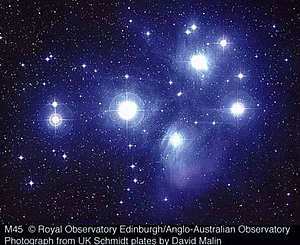
AAO Image of the Pleiades, M45, by David Malin
To the upper right of Taurus lies the open cluster, M45, the Pleiades. Often called the Seven Sisters, it is one of the brightest and closest open clusters. The Pleiades cluster lies at a distance of 400 light years and contains over 3000 stars. The cluster, which is about 13 light years across, is moving towards the star Betelgeuse in Orion. Surrounding the brightest stars are seen blue reflection nebulae caused by reflected light from many small carbon grains. These relfection nebulae look blue as the dust grains scatter blue light more efficiently than red. The grains form part of a molecular cloud through which the cluster is currently passing. (Or, to be more precise, did 400 years ago!)
Close to the tip of the left hand horn lies the Crab Nebula, also called M1 as it is the first entry of Charles Messier's catalogue of nebulous objects. Lying 6500 light years from the Sun, it is the remains of a giant star that was seen to explode as a supernova in the year 1056. It may just be glimpsed with binoculars on a very clear dark night and a telescope will show it as a misty blur of light.
Its name "The Crab Nebula" was given to it by the Third Earl of Rosse who observed it with the 72 inch reflector at Birr Castle in County Offaly in central Ireland. As shown in the drawing above, it appeared to him rather lile a spider crab. The 72 inch was the world's largest telelescope for many years. At the heart of the Crab Nebula is a neutron star, the result of the collapse of the original star's core. Although only around 20 km in diameter it weighs more than our Sun and is spinning 30 times a second. Its rotating magnetic field generate beams of light and radio waves which sweep across the sky. As a result, a radio telescope will pick up very regular pulses of radiation and the object is thus also known a Pulsar. Its pulses are monitored each day at Jodrell Bank with a 13m radio telescope.
The constellation Orion
Orion, perhaps the most beautiful of constellations, will be seen in the south at around 11 - 12 pm during January. Orion is the hunter holding up a club and shield against the charge of Taurus, the Bull up and to his right. Alpha Orionis, or Betelgeuse, is a read supergiant star varying in size between three and four hundred times that of our Sun. The result is that its brightness varies somewhat. Beta Orionis, or Rigel, is a blue supergiant which, at around 1000 light years distance is about twice as far away as Betelgeuse. It has a 7th magnitude companion. The three stars of Orion's belt lie at a distance of around 1500 light years. Just below the lower left hand star lies a strip of nebulosity against which can be seen a pillar of dust in the shape of the chess-board knight. It is thus called the Horsehead Nebula. It shows up very well photographically but is exceedingly difficult to see visually - even with relativly large telescope.
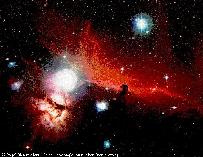
The Horsehead Nebula: Anglo Australian Observatory
Beneath the central star of the belt lies Orion's sword containing one of the most beautiful sights in the heavens - The Orion Nebula. It is a region of star formation and the reddish colour seen in photographs comes from Hydrogen excited by ultraviolet emitted from the very hot young stars that make up the Trapesium which is at its heart. The nebula, cradling the trapesium stars, is a beautiful sight in binoculars or, better still, a telescope. To the eye it appears greenish, not red, as the eye is much more sensitive to the green light emitted by ionized oxygen than the reddish glow from the hydrogen atoms.
The constellation Ursa Major
The stars of the Plough, shown linked by the thicker lines in the chart above, form one of the most recognised star patterns in the sky. Also called the Big Dipper, after the soup ladles used by farmer's wives in America to serve soup to the farm workers at lunchtime, it forms part of the Great Bear constellation - not quite so easy to make out! The stars Merak and Dubhe form the pointers which will lead you to the Pole Star, and hence find North. The stars Alcor and Mizar form a naked eye double which repays observation in a small telescope as Mizar is then shown to be an easily resolved double star. A fainter reddish star forms a triangle with Alcor and Mizar.
Ursa Major contains many interesting "deep sky" objects. The brightest, listed in Messier's Catalogue, are shown on the chart, but there are many fainter galaxies in the region too. In the upper right of the constellation are a pair of interacting galaxies M81 and M82 shown in the image below. M82 is undergoing a major burst of star formation and hence called a "starburst galaxy". They can be seen together using a low power eyepiece on a small telescope.
Another, and very beautiful, galaxy is M101 which looks rather like a pinwheel firework, hence its other name the Pinwheel Galaxy. It was discovered in1781 and was a late entry to Messier's calalogue of nebulous objects. It is a type Sc spiral galaxy seen face on which is at a distance of about 24 million light years. Type Sc galaxies have a relativly small nucleus and open spiral arms. With an overall diameter of 170,000 light it is one of the largest spirals known (the Milky Way has a diameter of ~ 130,000 light years).
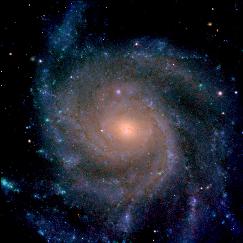
M101 - The Ursa Major Pinwheel Galaxy
Though just outside the constellation boundary, M51 lies close to Alkaid, the leftmost star of the Plough. Also called the Whirlpool Galaxy it is being deformed by the passage of the smaller galaxy on the left. This is now gravitationally captured by M51 and the two will eventually merge. M51 lies at a distance of about 37 million light years and was the first galaxy in which spiral arms were seen. It was discovered by Charles Messier in 1773 and the spiral structure was observed by Lord Rosse in 1845 using the 72" reflector at Birr Castle in Ireland - for many years the largest telescope in the world.
Lying close to Merak is the planetary nebula M97 which is usually called the Owl Nebula due to its resemblance to an owl's face with two large eyes. It was first called this by Lord Rosse who drew it in 1848 - as shown in the image below right. Planetary nebulae ar the remnants of stars similar in size to our Sun. When all possible nuclear fusion processes are complete, the central core collpses down into a "white dwarf" star and the the outer parts of the star are blown off to form the surrounding nebula.
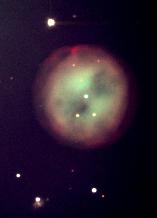
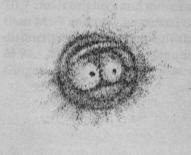
M97 - The Owl Planetary Nebula Lord Rosse's 1848 drawing of the Owl Nebula

